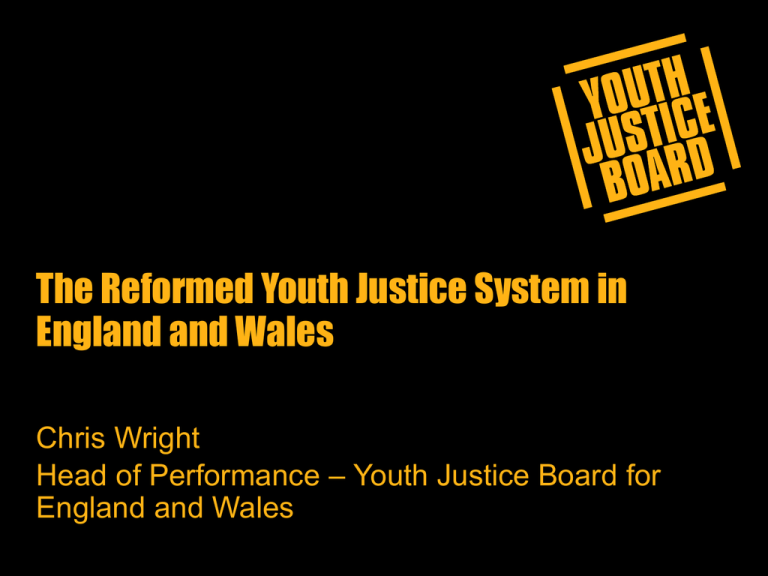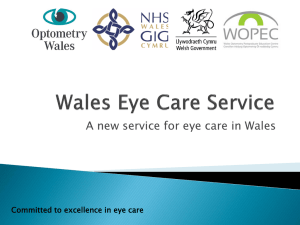The Joint Conference on Network around Juvenile Offenders
advertisement

The Reformed Youth Justice System in England and Wales Chris Wright Head of Performance – Youth Justice Board for England and Wales Content The reform process The role of the Youth Justice Board Youth Offending Teams – multi-agency partnerships Structured Assessment Performance management Impact Youth Justice Board for England and Wales 2 The Reforms Misspent Youth - 1996 Reform Crime and Disorder Act 1998 Re-organised services Structured pre-court interventions Choice of sentences Speed and engagement Choice of intervention Performance management Youth Justice Board for England and Wales 3 Statutory Principal Aim The principal statutory aim of the youth justice system: “The prevention of offending by children and young people” Crime and Disorder Act Youth Justice Board for England and Wales 4 Elements of the new arrangements Youth Justice Board for England and Wales 5 Organisation Local Youth Offending Teams Established by local authorities 5-service partnerships Common objectives and culture National Youth Justice Board Standards, drives delivery Home Office – law and policy Youth Justice Board for England and Wales 6 Pre-court Reprimand, Final Warning (replacing multiple cautioning) Police –Yot interface 50% of throughput (c.80,000 disposals per annum) Interventions, restorative justice Court at third offence Youth Justice Board for England and Wales 7 Courts Youth court Speed – the Persistent Young Offender Pledge - PYO (Tackling delay) Engagement Crown Court Youth Justice Board for England and Wales 8 Sentences/Interventions Reparation and Action Plan Orders Attendance Centres Community sentences Intensive Supervision and Surveillance (tagging) 2 part custody – the Detention and Training Order; (Yot lead) Referral Orders (Restorative Justice Panel – comprising community volunteers) Youth Justice Board for England and Wales 9 The structural arrangements for the reformed system Youth Justice Board for England and Wales 10 The Youth Justice Board for England and Wales Established by 1998 Crime and Disorder Act Independent non-departmental government body Up to 12 Board members and executive Advises Home Secretary on the operation of the YJS Monitors the operation of the YJS Youth Justice Board for England and Wales 11 The Youth Justice Board for England and Wales (cont’d) Awards grants in the pursuance of best practice Commission and purchase secure residential places Commission research and disseminate effective practice Place young people into secure accommodation Youth Justice Board for England and Wales 12 National and local accountabilities Welsh Assembly HOME OFFICE (CORRECTIONAL SERVICES) Department for Education and Skills Department of Health DEPT FOR CONSTITUTIONAL AFFAIRS COURTS YOUTH JUSTICE BOARD (NDPB) CUSTODIAL PROVIDERS •PRISON SERVICE •LOCAL AUTHORITY SECURE •INDEPENDENT SECTOR LOCAL AUTHORITY CHIEF EXECUTIVE POLICE YOUTH OFFENDING TEAMS (YOTS) 154 – LOCAL FOCUS HEALTH SOCIAL SERVICES Youth Justice Board for England and Wales PROBATION EDUCATION 13 Local Structure Local Authority Youth Offending Teams (Yots) Multi-agency teams: Including Police, Probation, Health, Education and Social Services Overseen by Partnership management boards Links to other statutory and community agencies Youth Justice Board for England and Wales 14 Local Structure (Cont’d) Locally funded with additional national YJB grants Responsible for the planning and provision of youth justice services Youth Justice Board for England and Wales 15 Resources for Yots 2004-2005 Police 9.6% Youth Justice Board 21.1% Probation 7.6% Local Authority Chief Executive 10.3% Health 4.8% Education 5.8% Youth Justice Board for England and Wales Social Services 40.9% 16 Assessment Youth Justice Board for England and Wales 17 Structured Assessment - Asset Comprehensiveness Consistency Quality Openness Resource allocation Develop evidence base Measure the impact of supervision Youth Justice Board for England and Wales 18 Key requirements for Asset Appropriate for offenders aged 10-17 For use at different points in YJ system Identify key risk factors Provide a score to predict re-offending Measure change over time Assess risk of serious harm Highlight issues for further assessment Youth Justice Board for England and Wales 19 ASSET takes into account static (unchangeable) factors and dynamic factors which help identify targets for intervention includes criminogenic and welfare needs identifies problems and positive factors combines numeric element with emphasis on evidence for decisions Youth Justice Board for England and Wales 20 Stages at which Asset is used in the Youth Justice System Final Warnings Final Warning Asset (short) Court Bail/Remands Bail Asset (short) Referral Orders Pre Sentence Reports/ SSIs Mid Order (ISSPs, DTOs) End of Order Youth Justice Boardorders) for England and Wales (all RO Panel APOs ACOs SOs CPOs CPROs DTOs S53/92 Core Asset Profile ‘What do YOU think?’ 21 ASSET - Purposes An aid to professional judgement An aid to case management An aid to the development of knowledge An aid to the management of resources ASSET is a tool for use - not a substitute for professional judgement or simply a paper exercise Youth Justice Board for England and Wales 22 Components of ASSET Core Profile Offending Career Living Arrangements Motivation Family & personal Attitudes to offending Offending behaviour Thinking Behaviour Perception self / others Emotional /Mental Health Youth Justice Board for England and Wales Education Employment Neighbourhood Lifestyle Physical health Substance Use 23 Positive Factors Strong/stable relationships with adults Education/work enhances confidence Friends not involved in offending Positive and constructive use of spare time Self efficacy Having goals and ambitions and life aims Opportunity for “turning points” Resilience Available help and support Youth Justice Board for England and Wales 24 Indicators of Vulnerability and Self-harm Could the young person be vulnerable as a result of the behaviour of others? Could the young person be vulnerable as a result of other events or circumstances? Could the young person be vulnerable as a result of his/her own behaviour? Could the young person be at risk of self-harm or suicide? What are the protective factors that might reduce his/her vulnerability and the risk of self-harm Youth Justice Board for England and Wales 25 Indicators of Serious Harm to Others Evidence of previous serious harmful behaviour Indicators of intentions to harm Potentially significant other behaviour (e.g. cruelty to animals) Youth Justice Board for England and Wales 26 Consider the following: Were these factors linked to past offending are they more or less relevant now? Direct or indirect link Always relevant to offending or only on certain occasions Is the effect on offending behaviour immediate or over a longer period Will it lead to offending by itself or only in association? Not associated at all Slight, occasional, limited, indirect Moderate but definite Quite a strongly associated, normally a direct link, relevant to most types / occasions of offending Very strongly associated. Clear direct link, dominant factor Interventions Youth Justice Board for England and Wales 29 Effective Practice -interventions Evidence base Thematic approach Key Elements of effective practice (15) Quality Assurance process (Yot self-assessment and YJB validation) Measure compliance – practitioners, managers and strategic partners Improvement plans Revise evidence base Youth Justice Board for England and Wales 30 Identify interventions that are effective in addressing risk factors through research and monitoring Deliver support and resources to address gaps in performance Promote the application of effective interventions through grants, practice guidance, and learning programmes Monitor the performance of the youth justice system to identify gaps in effective practice and emerging best practice Youth Justice Board for England and Wales 31 Performance Management An approach towards continuous improvement Youth Justice Board for England and Wales 32 Yot performance framework The different components of the Youth Justice Board’s performance framework are intended to ensure that the Board’s corporate aims and objectives for the youth justice system are delivered Youth Justice Board for England and Wales Youth Justice Plan 33 Yots are also influenced by other performance frameworks PPOs: Prevent & Deter Reduction in permanent exclusions Anti-social behaviour & youth nuisance Youth Justice Plan DIP measures: drug testing & treatment Robbery / street crime reduction Youth Justice Board for England and Wales Accommodation stability for looked after children Reduction in the proportion of 16-18 NEETs Early identification of at risk young people (CAF) 34 Yot Assessment Framework – using a basket of measures General 5% KPI Youth Justice Plan Recidivism Performance 15% 20% EPQA KPI Improvement Improvement 10% 12.5% EPQA 12.5% National Standards 25% Performance Weighting Youth Justice Board for England and Wales 35 Underlying drivers of Yot performance Performance and Quality Systems • Effectiveness of performance management – 13 indicators/EPQA • Accuracy and value of data • Ownership of targets by staff • Internal administration Governance and Leadership • Composition and operation of steering group • Position within local authority • Links with other strategic bodies • Leadership Partnership Working • Financial and operational support for Yot performance Performance Performance Local context People and Organisation • Volume and risk of offenders • Deprivation • Infrastructure of services (rural) [Local context influences performance but is unlikely to change in the short-term] • Recruitment and retention • Performance management • Training and skills • Yot organisational structure Resources Youth Justice Board for England and Wales • Staff recruitment and retention • Adequacy of resourcing for workload • Range and quality of programmes 36 Need an in-depth understanding of performance to target improvement effort High Star? Progress on underlying drivers now needs to feed through into improved performance Strong performance and foundations Struggler? Is there a credible improvement strategy in place with senior buyin? Capacity and Capability Improver? Low Concerns? Performance improvement is unstable or weaknesses emerging that may hit performance? Performance KPI data Youth Justice Board for England and Wales High 37 Outcomes Youth Justice Board for England and Wales 38 The Earlier You Intervene the Better…. Pre Court First Tier Second Tier Custody Youth Justice Board for England and Wales No. 74,000 48,000 28,000 8,000 Recidivism 35% 58% 74% 73% 39 Main Findings from Yot recidivism cohorts Consistency in overall results over time. Re-offending After 24 Months 2000 2001 2002 Pre-Court 34.3% 34.0% 35.4% First – Tier 56.6% 57.1% 57.7% Comm-Pens 70.0% 69.4% 73.8% Custody 69.9% 71.5% 72.7% Total 47.8% 48.2% 50.0% Youth Justice Board for England and Wales 40 A success story? Still much progress to be made but: 156 Yots established A model for public sector service delivery (Audit Commission 2004) By 2002 the re-offending rate for young offenders had dropped by 7.4% compared with 1997 Progressing towards achieving 80% of youth justice workforce having benefited from National Qualification Framework Youth Justice Board for England and Wales 41 But! Very high use of custody (currently c. 3,000) Re-offending levels slipping back towards 1997 figures Constantly changing service delivery environment Need to maintain focus on youth crime prevention and reduction Youth Justice Board for England and Wales 42 Thank You www.youth-justice-board.gov.uk Youth Justice Board for England and Wales 43








